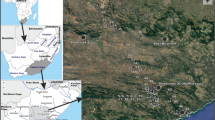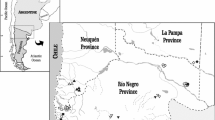Abstract
An ecological calibration dataset for freshwater ostracods from 33 localities throughout West-Pomerania (Mecklenburg-Vorpommern, Germany) was evaluated using multivariate statistical methods. A total of 47 freshwater ostracod species were identified. Nine species were rediscovered after 100 years since the last published record and Candonopsis scourfieldi and Pseudocandona sucki was recorded for the first time in the study area. Special emphasis is put on the phenology of each species to gain information on the water characteristics at the time of their last moult. Canonical correspondence analysis (CCA) revealed that the ecological variables such as water temperature, Ca, Mg, and lake area were statistically most significant (p < 0.005; n = 72) in explaining variation in the distribution of ostracod assemblages. In addition, a transfer function was developed for paleolimnological approaches, based on a weighted-averaging (WA) model to calculate water temperature from the relative abundances of 22 selected ostracod species. This model was successfully applied to infer lake water temperature from subfossil ostracod assemblages collected from lacustrine deposits in northeast Germany (Lake Krakower See).
Similar content being viewed by others
References
Alin S. R. and Cohen A. S. (2003). Lake-level history of Lake Tanganyika, East Africa, for the past 2500 years based on ostracode-inferred water-depth reconstruction. Palaeogeography Palaeoclimatology Palaeoecology 199: 31–49
Birks H. J. B. (1995). Quantitative palaeoenvironmental reconstructions. In: Maddy, D. and Brew, J. S. (eds) Statistical modelling of Quaternary science data, 5, pp 161–254. Quaternary Research Association, Cambridge
Boomer I., Horne D. J. and Slipper I. J. (2003). The use of ostracods in Palaeoenvironmental studies, or what can you do with an ostracod shell?. Paleontological Society Papers 9: 153–180
Boomer I., Whatley R. and Aladin N. V. (1996). Aral Sea Ostracoda as environmental indicators. Lethaia 29: 77–85
Colman S. M., Forester R. M., Reynolds R. L., Sweetkind D. S., King J. W., Gangemi P., Jones G. A., Keigwin L. D. and Foster D. S. (1994). Lake-level history of Lake Michigan for the past 12,000 years: The record from deep lacustrine sediments. Journal of Great Lakes Research 20: 73–92
Colman S. M., Jones G. A., Forester R. M. and Foster D. S. (1990). Holocene paleoclimatic evidence and sedimentation rates from a core in southwestern Lake Michigan (USA). Journal of Paleolimnology 4: 269–283
(2002). Ostracod palaeoecology. In: Holmes, J. A. and Chivas, A. R. (eds) The ostracoda: applications in Quaternary research, 131, pp 121–134. American Geophysical Union, Washington, DC
(1989). Deutsche Einheitsverfahren zur Wasser-, Abwasser- und Schlammuntersuchung. Verlag Chemie, Weinheim
Duphorn K., Kliewe H., Niedermeyer R. -O., Janke W., Werner F., 1995. Die deutsche Ostseeküste. In: Sammlung Geologischer Führer, vol. 88, Bornträger, Berlin, Stuttgart, pp 281
Forester R. M. (1991). Ostracode assemblages from springs in the western USA: Implications for paleohydrology. Memoirs Of The Entomological Society Of Canada 155: 181–202
Frenzel P. and Viehberg F. A. (2004). Checklist of Recent und Quaternary ostracods (Crustacea) from freshwater, brackish and marine environments in Mecklenburg-Vorpommern, NE-Germany. Revista Española de Micropaleontologia 36: 29–55
Ganning B. (1971). On the ecology of Heterocypris salinus, H. incongruens and Cypridopsis aculeata (Crustacea : Ostracoda) from Baltic brackish-water rockpools. Marine Biology. International Journal on Life in Oceans and Coastal Waters 8: 271–279
Gell P. A., Barker P. A., Last W. M. and Jelicic L. (1994). The Holocene history of West Basin lake, Victoria, Australia: chemical changes based on fossil biota and sediment mineralogy. Journal of Paleolimnology 12: 235–258
Hiller D. (1972). Untersuchungen zur Biologie und zur Ökologie limnischer Ostracoden aus der Umgebung von Hamburg. Archiv für Hydrobiologie 40: 400–497
Hollwedel W. and Scharf B. W. (1994). Zur Verbreitung der Cladoceren und Ostracoden auf den Ostseeinseln Rügen und Hiddensee. Drosera, Oldenburg 1994: 21–28
Hollwedel W. and Scharf B. W. (1996). Zur Verbreitung der Cladoceren und Ostracoden (Crustacea) in Gewässern des Müritz-Nationalparks (Mecklenburg-Vorpommern). Braun- schweiger Naturkundliche Schriften 5: 91–104
Holmes J. A. (2003). Future trends and goals in ostracode research. Paleontological Society Papers 9: 275–290
Holmes J. A. and Chivas A. R. (2002). Ostracod shell chemistry - overview. In: Holmes, J. A. and Chivas, A. R. (eds) The Ostracoda: applications in Quaternary research, 131, pp 185–204. American Geophysical Union, Washington, DC
Imbrie J. and Kipp N. G. (1971). A new micropaleontological method for quantitative paleoclimatology: application to a late Pleistocene Caribbean core. In: Turekian, K. K. (eds) The Late Cenozoic glacial ages, pp 71–181. Yale University Press, New Haven, CT
Juggins S. (2003). Tutorial C2: software for ecological and palaeoecological data analysis and visualisation. University of Newcastle, Newcastle upon Tyne, UK
Kaiser K. (2001). Die spätpleistozäne bis frühholozäne Beckenentwicklung in Mecklenburg-Vorpommern. Greifswalder Geographische Arbeiten 24: 1–259
Külköylüoglu O. and Dügel M. (2004). Ecology and spatiotemporal patterns of Ostracoda (Crustacea) from Lake Golcuk (Bolu, Turkey). Archiv für Hydrobiologie 160: 67–83
Lorenz S., 2002. Die Uferstrukturen des Krakower Sees in Mecklenburg – Naturräumliche Analyse und jungquartäre Paläohydrologie. Diploma thesis, University of Greifswald, Greifswald, Germany
Lotter A. F., Walker I. R., Brooks S. J. and Hofmann W. (1999). An intercontinental comparison of chironomid palaeotemperature interference models: Europe vs. North America. Quaternary Science Reviews 18: 717–735
LUNG M-V, 2001. Gewässergütebericht Mecklenburg-Vorpommern 1998/1999: Ergebnisse der Güteüberwachung der Fließ-, Stand- und Küstengewässer und des Grundwassers in Mecklenburg-Vorpommern. Landesamt für Umwelt, Naturschutz und Geologie Mecklenburg-Vorpommern, Güstrow
Martens K., DeDeckker P. and Marples T. G. (1985). Life history of Mytiolocypris henricae Chapman. Crustacea: Ostracoda. Australian Journal of Marine and Freshwater Research 36: 807–819
Meisch C. (2000). Freshwater Ostracoda of Western and Central Europe. In: Schwoerbel, J. and Zwick, P. (eds) Süßwasserfauna von Mitteleuropa, vol. 8/3, pp 522. Akademischer Verlag Spektrum, Heidelberg
Mourguiart P., Correge T., Wirrmann D., Argollo J., Montenegro M. E., Pourchet M. and Carbonel P. (1998). Holocene palaeohydrology of Lake Titicaca estimated from an ostracod-based transfer function. Palaeogeography Palaeoclimatology Palaeoecology 143: 51–72
Müller O. F. (1772). Observations on some bivalved insects, found in common water, by Mr Mueller, of the Academy of Sciences in Bavaria and the Oeconomical Society at Bern (Communicated by R.H.A. Bennet, Esq.). Philosophical Transactions Of The Royal Society Of London 61: 230–246
Müller U., Rühberg N. and Krienke H.-D. (1995). The Pleistocene sequence in Mecklenburg-Vorpommern. In: Ehlers, J., Kozarski, S., and Gibbard, P. (eds) Glacial deposits in North-East Europe, pp 501–516. A.A. Balkema, Rotterdam
Namiotko T., Wisniewska B. and Milosek A. (1993). Changes of Lake Hancza (NE Poland) ecological state in the last fifty years with particular attention being paid to the profundal ostracoda fauna. Polskie Archiwum Hydrobiologii 40: 267–290
Pienitz R., Smol J. P. and Birks H. J. B. (1995). Assessment of freshwater diatoms as quantitative indicators of past climatic change in the Yukon and Northwest Territories, Canada. Journal of Paleolimnology 13: 21–49
Redeke H. C. (1936). Flora und Fauna der Zuidersee. Monografie van een Brakwatergebied, Den Helder
Rossetti G., Bartoli M. and Martens K. (2004). Limnological characteristics and recent ostracods (Crustacea, Ostracoda) of freshwater wetlands in the Parco Oglio Sud (Northern Italy). Annales Limnologie - International Journal of Limnology 40: 329–341
Scharf B. W. (1998). Eutrophication history of lake Arendsee (Germany). Palaeogeography Palaeoclimatology Palaeoecology 140: 85–96
Schwalb A. (2003). Lacustrine ostracodes as stable isotope recorders of late-glacial and Holocene environmental dynamics and climate. Journal of Paleolimnology 29: 267–351
Smith, A. J., Delorme L. D., Forester R. M., 1992. A lake’s solute history from ostracodes: Comparison of methods. In: Maest Kharaka (eds), Low temperature environments 677–680
Sywula, T., 1974: Malzoraczki (Ostracoda). In: Fauna Slodkowodna Polski, vol. 24, Panstwowe Wydawnictwo Naukowe, Poznan, 315 pp
ter Braak, C. J. F., 1987. Ordination. In: Jongman R. H. G., ter Braak C. J. F., van Tongeren O. F. R. (eds) Data analysis in community and landscape ecology Cambridge University Press, Pudoc, Wageningen, pp 91–290
ter Braak C. J. F. and Looman C. W. N. (1986). Weighted averaging, logistic regression and the Gaussian response model. Vegetatio 65: 3–11
ter Braak C. J. F. and Šmilauer P. (2002). CANOCO Reference manual and CanoDraw for Windows user’s guide: software for canonical community ordination (version 4.5). Microcomputer Power, Ithaca, NY
UM-MV, 1998. Gewässergütebericht Mecklenburg-Vorpommern 1996/1997: Zustand der Gewässergüte von Fließ-, Stand- und Küstengewäsern und der Grundwasserbeschaffenheit in Mecklenburg-Vorpommern. Vol. 7, Umweltministerium Mecklenburg-Vorpommern, Schwerin
Vesper B. (1975). Ein Beitrag zur Ostracodenfauna Schleswig- Holsteins. Mitteilungen aus dem Hamburgischen Zoologischen Museum und Institut 72: 97–108
Viehberg F. A. (2001). Neue Erkenntnisse zur Ostrakodenfauna (Crustacea) von Greifswald und Umgebung. Naturschutzarbeit in Mecklenburg-Vorpommern 44: 57–60
Viehberg F. A. (2002). A new and simple method for qualitative sampling of meiobenthos-communities. Limnologica 32: 350–351
Viehberg F. A. (2004). Paleolimnological study based on ostracods (Crustacea) in Late-glacial and Holocene deposits of Lake Krakower See in Mecklenburg-Vorpommern, NE Germany. Studia Quaternaria 21: 109–115
Yilmaz F. and Külköylüoglu O. (2006). Tolerance, optimum ranges and ecological requirements of freshwater Ostracoda (Crustacea) in Lake Aladag (Bolu, Turkey). Ecological Research 21: 165–173
Author information
Authors and Affiliations
Corresponding author
Electronic supplementary material
Rights and permissions
About this article
Cite this article
Viehberg, F.A. Freshwater ostracod assemblages and their relationship to environmental variables in waters from northeast Germany. Hydrobiologia 571, 213–224 (2006). https://doi.org/10.1007/s10750-006-0241-x
Received:
Revised:
Accepted:
Published:
Issue Date:
DOI: https://doi.org/10.1007/s10750-006-0241-x




